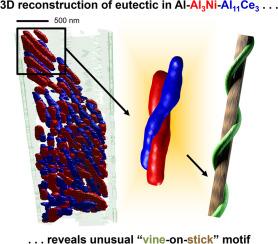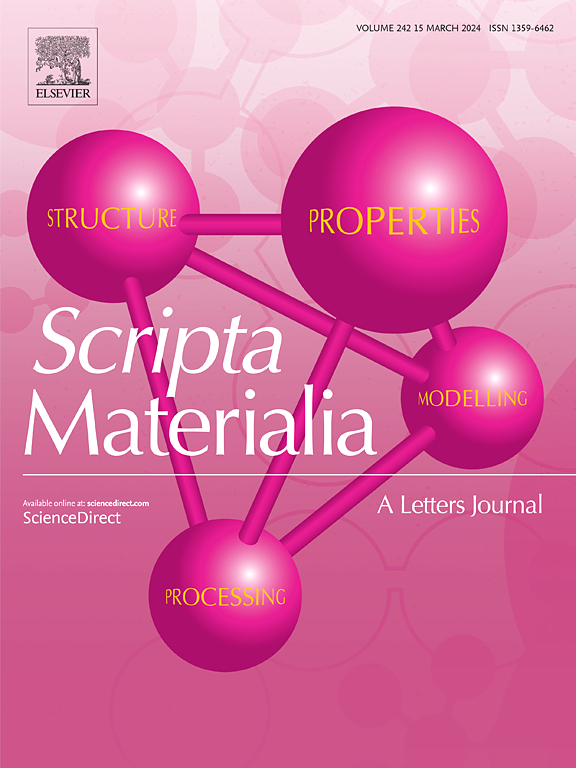研究Al-Ce-Ni体系中纳米尺度的“枝上藤”共晶结构
IF 5.6
2区 材料科学
Q2 MATERIALS SCIENCE, MULTIDISCIPLINARY
引用次数: 0
摘要
多相共晶通常由具有纳米级周期性的纠缠固相组成,这使得使用传统的二维技术很难解开它们的三维连通性。在这些体系中,三相共晶Al-Al11Ce3-Al3Ni以其超细(~ 100 nm)的界面间距和良好的抗蠕变性能而脱颖而出,尽管其具有高温应用潜力,但其微观结构仍相对未被探索。在这里,我们使用扫描硬x射线显微镜,具有前所未有的~ 10纳米像素尺寸来解析其3D形态。重建显示了一种新颖的“藤蔓在棍子上”的图案,其中Al11Ce3包裹在Al3Ni柱上。相弯曲度分析证实Al11Ce3比Al3Ni表现出更复杂的形貌。两种金属间化合物之间没有取向关系,表明生长受局部溶质梯度而不是外延控制。金属间化合物沿其纵轴的破碎表明在固态中存在瑞利型破碎机制。这种“藤上枝”模式可以推广到其他具有可变界面各向异性和低相互溶解度的合金体系。本文章由计算机程序翻译,如有差异,请以英文原文为准。

Shining light on nanoscale ‘vine-on-stick’ eutectic structures in the Al-Ce-Ni system
Multiphase eutectics often comprise entangled solid phases with nanoscale periodicity, making it difficult to unravel their 3D connectivity using conventional 2D techniques. Among such systems, the three-phase eutectic Al-Al11Ce3-Al3Ni stands out for its ultrafine (∼100 nm) interphase spacing and promising creep resistance, yet its microstructure remains relatively unexplored despite its potential for high-temperature applications. Here, we use scanning hard X-ray microscopy with an unprecedented ∼10 nm pixel size to resolve its 3D morphology. Reconstructions reveal a novel “vine-on-stick” motif, wherein Al11Ce3 wraps around Al3Ni pillars. Analysis of phase tortuosities confirms that Al11Ce3 exhibits more convoluted morphologies than Al3Ni. No orientation relationship was observed between the two intermetallics, suggesting that growth is controlled by local solute gradients rather than epitaxy. Fragmentation of intermetallics along their longitudinal axis suggests a Rayleigh-type breakup mechanism in solid state. The “vine-on-stick” pattern may generalize to other alloy systems with variable interfacial anisotropies and low mutual solubilities.
求助全文
通过发布文献求助,成功后即可免费获取论文全文。
去求助
来源期刊

Scripta Materialia
工程技术-材料科学:综合
CiteScore
11.40
自引率
5.00%
发文量
581
审稿时长
34 days
期刊介绍:
Scripta Materialia is a LETTERS journal of Acta Materialia, providing a forum for the rapid publication of short communications on the relationship between the structure and the properties of inorganic materials. The emphasis is on originality rather than incremental research. Short reports on the development of materials with novel or substantially improved properties are also welcomed. Emphasis is on either the functional or mechanical behavior of metals, ceramics and semiconductors at all length scales.
 求助内容:
求助内容: 应助结果提醒方式:
应助结果提醒方式:


